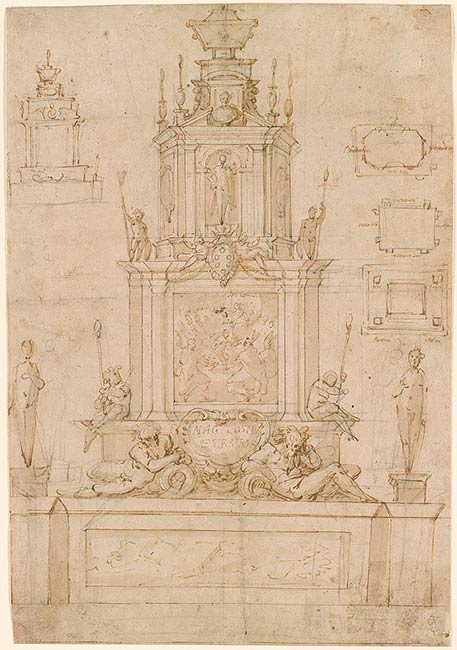
Many extant sixteenth-century drawings are for ephemeral structures, and these are in some instances quite difficult to identify with precision. That is not the case with this sheet, however, the iconography and inscriptions of which clearly indicate that it is a study for a catafalque dedicated to Grand Duke Cosimo I de’ Medici, who died on 21 April 1574. Following Cosimo’s death, such catafalques were set up throughout Italy. The drawing was acquired in 1965, at which time its stylistic affinity with Vasari was recognized. Since then, it has been attributed with some authority to his pupil Jacopo Zucchi and tentatively connected with the catafalque erected at the expense of Zucchi’s patron Ferdinando de’ Medici in San Giovanni dei Fiorentini, Rome.
The drawing depicts a three-story structure surmounted by a bust of the deceased and a coffin. On the left is an alternate design for the elevation of the monument, while the three sketches on the right are the plans for each story. Inscriptions identify the various allegories and scenes to be represented. The four statues of the lower story were to represent the principal cities of Tuscany; reliefs on the second story were to depict the four major events of Cosimo’s life (the scene visible on the second story of the large elevation is Cosimo’s coronation); and allegories of the virtues of the grand duke. Two other drawings by Zucchi for the same catafalque are known, conserved in the Yale University Art Gallery, New Haven, and the Kupferstichkabinett, Berlin, respectively.2 The Morgan and Yale sheets were once a part of the same album, which was disassembled by P. and D. Colnaghi & Co., Ltd. in the mid-1960s.3
Footnotes:
- Yale University Art Gallery, New Haven, inv. 1986.117.2; Kupferstichkabinett, Berlin, inv. KdZ 424.
- Fellows Report, 1967, 106. The album is described as being formed of “mostly Tuscan and Perugian drawings put together by an Italian collector at the end of the nineteenth century.”
Inscribed at upper center, flanking the sarcophagus, in pen and brown ink, Jacom Zucchi; in the cartouche, in pen and brown ink, MAG COSMUS / ETRURIE; plan at upper right, in pen and brown ink, liberalita / Carita / pruden[cut off by edge of sheet] / iustizia; plan beneath this, in pen and brown ink, (cavalieri)? / [creatione]? / trionfo / coronatione; lowest plan, in pen and brown ink, Pisa / carara / Siena / fiorenza; at center, near left edge, in black chalk, S4; on verso of lining, in graphite, 71 (encircled); D 28044EX (Colngahi stock number).
Watermark: knight holding a cross, inside a shield, running figure with cross, centered on chain lne.
Morandini, Francesco, 1544-1597, Formerly attributed to.
Campello, Lanfranco di, count, former owner.
Selected references: Borsook 1965-66, 50-53 (as Poppi); Fellows Report 1967, 106-7 (as anonymous); Pillsbury 1969, 64, note 22; Notre Dame and Binghampton 1970, 81, no. D26 (as attributed to Zucchi); Cleveland 1971, no. 60; Madison 1973, no. 14, (as attributed to Zucchi); Pillsbury 1974, 16-18; Oberlin and Elsewhere 1991-92, 204-205, no. 58, (as Zucchi); Aurigemma 2007, 119-120.
Eve Borsook, The Mural Painters of Tuscany, London, 1960, 2nd rev. ed., Oxford, 1980, pp. 50-53, repr. fig.11 (Francesco Morandini, il Poppi).
A review of acquisitions, 1949-1968 / Pierpont Morgan Library. New York : The Library, 1969, p. 151.
The Age of Vasari, University of Notre Dame Art Gallery, Notre Dame, Indiana, and the University Art Gallery, State University of New York at Binghamton, 1970, p. 81, no. D26 (attributed to Jacopo Zucchi).
Edmund Pillsbury, Florence and the Arts: Five Centuries of Patronage, exh. cat., Cleveland Museum of Art, Cleveland, 1971, no. 60 (n.p.), repr.
Arthur R. Blumenthal, Italian Renaissance Festival Designs, exh. cat., Elvehjem Art Center, University of Wisconsin, Madison, 1973, no. 14, repr. (attributed to Jacopo Zucchi).
Edmund Pillsbury, "Drawings by Jacopo Zucchi", Master Drawings, 12, no. 1, Spring 1974, pp. 16-18, 30 note 64, and 33, pl. 18.
Larry J. Feinberg with an essay by Karen-edis Barzman, From Studio to Studiolo. Florentine Draftsmanship under the First Medici Grand Dukes, Allen Memorial Art Museum, Oberlin College, Oberlin, Ohio; Bowdoin College Museum of Art, Brunswick, Maine; and the Hood Museum of Art, Dartmouth College, Hanover, New Hampshire, 1991-92, pp. 204-205, no. 58, repr. (Jacopo Zucchi).
Maria Giulia Aurigemma, "Un corpus perduto? Sui disegni di Jacopo Zucchi", Studiolo, 5, 2007, pp. 119-120, 134.

